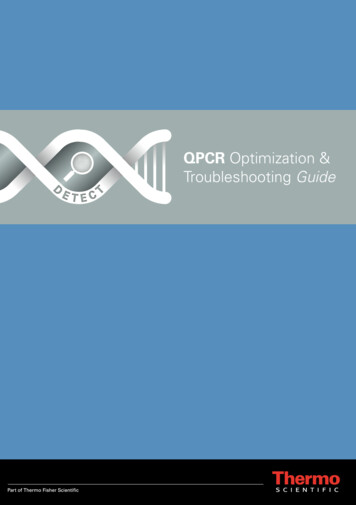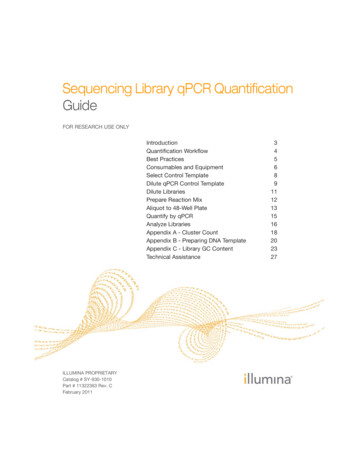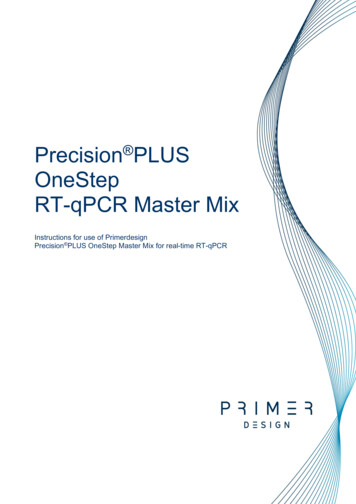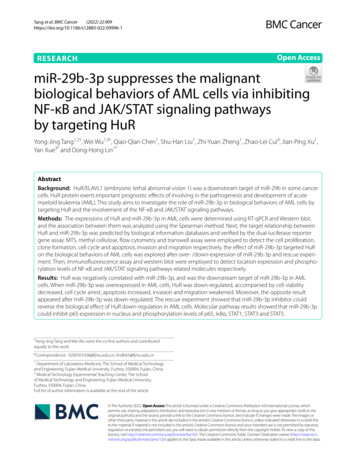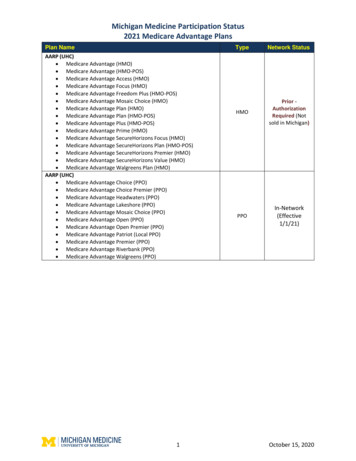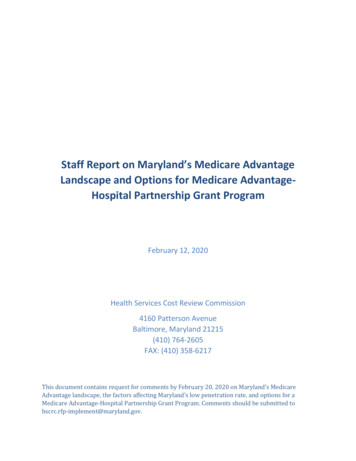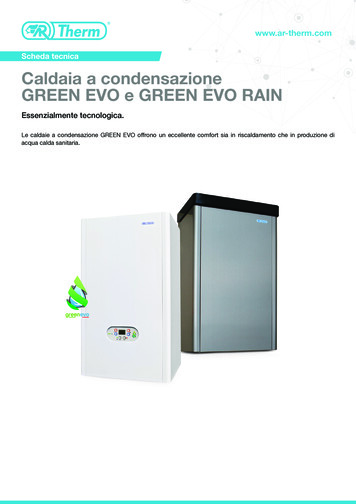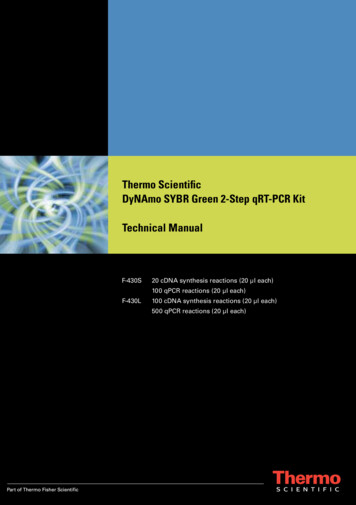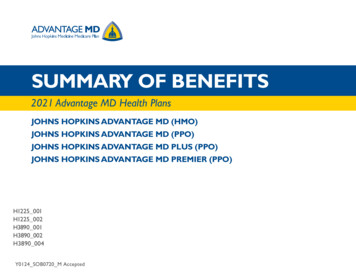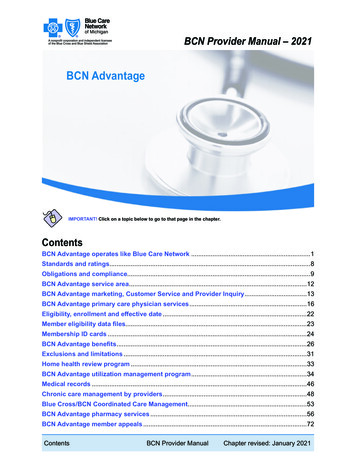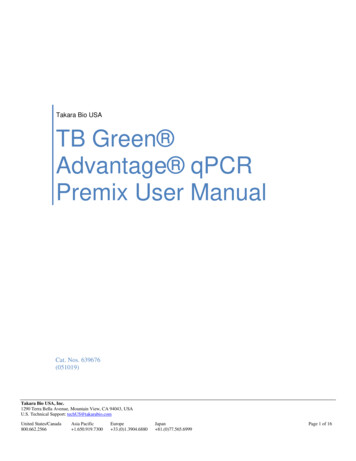
Transcription
Takara Bio USATB Green Advantage qPCRPremix User ManualCat. Nos. 639676(051019)Takara Bio USA, Inc.1290 Terra Bella Avenue, Mountain View, CA 94043, USAU.S. Technical Support: techUS@takarabio.comUnited States/Canada800.662.2566Asia Pacific 1.650.919.7300Europe 33.(0)1.3904.6880Japan 81.(0)77.565.6999Page 1 of 16
TB Green Advantage qPCR Premix User ManualTable of ContentsI.Introduction . 3A.II.Principle . 3List of Components . 4III.Additional Materials Required . 5IV.General Considerations . 5A.Recommended Precautions . 5B.Primer Design Guidelines . 5V.Real-Time PCR Protocols for Specific Instruments . 6A.qPCR Protocol using the Cepheid SmartCycler II System . 7B.qPCR Protocol using Applied Biosystems Instruments . 8C.qPCR Protocol using the Roche LightCycler. 10D.qPCR Protocol using the Stratagene Mx3000P . 12VI.Application Example. 14Table of FiguresFigure 1. Fluorescence detection by the intercalator method. 4Figure 2. PCR conditions for the application example (λ DNA detection, dilution series) . 14Figure 3. Amplification curves for the λ DNA PCR product. 14Figure 4. Melting curves for the λ DNA PCR product. . 15Figure 5. Standard curve for the λ DNA PCR amplification. . 15Table of TablesTable I. Primer Design Guidelines . 6Table II. PCR Reaction Mixture (Cepheid SmartCycler II). 7Table III. Initial Denaturation (Cepheid SmartCycler II) . 7Table IV. Two-Step PCR (Cepheid SmartCycler II) . 7Table V. Three-Step PCR (Cepheid SmartCycler II). 8Table VI. PCR Reaction Mixture (Applied Biosystems Instruments) . 9Table VII. Initial Denaturation (Applied Biosystems Instruments) . 9Table VIII. Two-Step PCR (Applied Biosystems Instruments) . 9Table IX. Three-Step PCR (Applied Biosystems Instruments) . 10Table X. PCR Reaction Mixture (Roche LightCycler) . 10Table XI. Initial Denaturation (Roche LightCycler) . 11Table XII. Two-Step PCR (Roche LightCycler). 11Table XIII. Three-Step PCR (Roche LightCycler) . 12Table XIV. PCR Reaction Mixture (Stratagene Mx3000P) . 12Table XV. Initial Denaturation (Stratagene Mx3000P) . 12Table XVI. Two-Step PCR (Stratagene Mx3000P) . 13Table XVII. Three-Step PCR (Stratagene Mx3000P). 13(051019)takarabio.comTakara Bio USA, Inc.Page 2 of 16
TB Green Advantage qPCR Premix User ManualI.IntroductionThe TB Green Advantage qPCR Premix is a reagent supplied at 2X concentration, consisting of a full-length Taqpolymerase with a hot-start Taq antibody and TB Green dye, that has been specially designed for real-time PCRusing the dye intercalator method.This product combines the high performance of our enzyme for hot-start PCR utilizing Taq antibody, with anewly developed buffer, to provide superior specificity, increased amplification efficiency, and superbperformance in high-speed real-time PCR.Use of the TB Green Advantage qPCR Premix enables you to carry out successful real-time PCR with highsensitivity, broad dynamic range, and accurate quantification.This reagent is supplied together with separate tubes of ROX Reference Dye LSR and ROX Reference Dye LMPthat can be used to normalize the fluorescent signal intensity between reactions for use with instruments that areequipped with this option. In one tube (LSR), ROX is provided at the optimal concentration for instrumentswhose excitation source is a 488 nm laser (e.g., the Applied Biosystems 7700 and 7900 instruments; in anothertube (LMP), ROX is provided at the optimal concentration for instruments whose excitation source is either alamp or an LED.This manual provides protocols for use of the TB Green Advantage PCR Premix with the following real-timePCR instruments: Cepheid SmartCyclerApplied Biosystems Instrumentso ABI PRISM 7000/7700/7900HT Sequence Detection Systemso Applied Biosystems 7300/7500 Real-Time PCR Systemso 7500 Fast Real Time PCR SystemRoche LightCyclerStratagene Mx3000PThis product is expected to work on other real-time PCR instruments in a similar fashion, although it has not yetbeen tested on these other instruments.A.PrincipleThis product employs a full-length Taq polymerase with hot-start antibody for the PCR reaction. PCRproducts are detected with TB Green dye in real-time monitoring.1.PCRPCR (Polymerase Chain Reaction) is a simple and powerful method to amplify a very smallamount of target DNA by cycling three incubation steps at different temperatures:1. Double-stranded target DNA is heat-denatured (denaturation step).2. The two primers complementary to the target segment are annealed at low temperature(annealing step).3. The annealed primers are then extended at the same, or an intermediate temperature(extension step) with a DNA polymerase.(051019)takarabio.comTakara Bio USA, Inc.Page 3 of 16
TB Green Advantage qPCR Premix User ManualThe target copy number doubles with each cycle, and therefore, PCR can amplify DNA fragmentsup to 106-fold in a short period. Because this product utilizes an enzyme for hot-start PCR, i.e.,full-length Taq with hot-start antibody, non-specific amplification due to mispriming prior tocycling or to primer-dimer formation can be minimized and highly specific and sensitivedetection is achieved.2.Fluorescence Detection by the Intercalator MethodThis is a detection method utilizing a DNA-intercalating dye that fluoresces once it binds todouble-stranded DNA (Figure 1). The most commonly used is green intercalating dye. The dye isadded in the reaction system and its fluorescence is detected during amplification. When anintercalator binds to double-stranded DNA synthesized during PCR amplification, fluorescence isemitted and detected during amplification. From measurements of the fluorescence intensity,plotted versus cycle number, amplification plots can be drawn. Moreover, after cycling has beencompleted, a melting curve analysis can be performed to determine the melting temperature (T m)of the amplified DNA.Figure 1. Fluorescence detection by the intercalator method.II.List of ComponentsThe TB Green Advantage qPCR Premix is available in the following two sizes:Cat. No. 639676 (suitable for 50 PCR reactions—25 μl rxn volume) TB Green Advantage qPCR Premix (2X)1ROX Reference Dye LSR (50X)2ROX Reference Dye LMP (50X)2625 µl x 4 tubes100 µl x 1 tube100 µl x 1 tube1TB Green Advantage qPCR Premix contains full-length Taq, hot-start Taq antibody, dNTP mixture, Mg2 , TB Green dye,and buffer.2ROX Reference Dyes used for normalization of intensity by background subtraction. For the ABI PRISM7000/7700/7900HT Sequence Detection Systems and the Applied Biosystems 7300 Real Time PCR System, the use of ROXReference Dye LSR (50X) is recommended. For the Applied Biosystems 7500 Real Time PCR System and the StratageneMx3000P, the use of ROX Reference Dye LMP is recommended. The use of ROX Reference Dye LSR or LMP is optional. Itis not required for use with Smart Cycler or LightCycler real-time instruments. The ROX LSR tube contains the optimalconcentration of ROX for instruments whose excitation source is a 488 nm laser. The ROX LMP tube contains the optimalconcentration of ROX for instruments whose excitation source is either a lamp or an LED.(051019)takarabio.comTakara Bio USA, Inc.Page 4 of 16
TB Green Advantage qPCR Premix User ManualIII.Additional Materials RequiredThe following equipment, materials, and reagents are required, but not supplied. Thermal cycler for real-time PCRReaction tube or plate for real-time PCRPCR-grade H2OMicropipet and micropipet tips (autoclaved prior to use)NOTE: We recommend filter tips to minimize contamination.IV.General ConsiderationsA.Recommended PrecautionsPlease be sure to read through the following precautions prior to starting the protocol.1. A white or yellowish precipitate may form in this product during frozen storage. This precipitate canbe completely dissolved by briefly warming the tube with your hands or by placing the tube at roomtemperature while protecting it from light, followed by inversion of the tube several times to mix untildissolved. If product containing precipitate is used for real-time amplification of DNA, decreasedsignal intensity and reduced reactivity may result due to an inadequate concentration of TB Green dyeand other components. USE THE REAGENT ONLY AFTER COMPLETELY RE-DISSOLVINGTHE PRECIPITATE to ensure a uniform concentration of components. Do not vortex. Even in theabsence of a precipitate, gentle mixing of the product (avoiding air bubbles) is recommended toprovide a uniform concentration of components prior to use.2. During preparation of the reaction mixture, all the reagents should be placed on ice.3. Avoid exposure to direct light in preparation of the PCR reaction mixture because TB Green dye isincluded, and it is light-sensitive.4. For preparing and dispensing the reagents, a new disposable tip should be used to minimizecontamination among samples.B.Primer Design GuidelinesIt is essential to design primers that allow good reactivity for a successful real-time PCR reaction. Pleasefollow the guidelines in Table I to design primers that offer high amplification efficiency and minimizethe formation of nonspecific reaction products.(051019)takarabio.comTakara Bio USA, Inc.Page 5 of 16
TB Green Advantage qPCR Premix User ManualTable I. Primer Design GuidelinesAmplified product size:Primer length:GC content:T m:Sequence:80–150 bp is recommended. (It is possible to amplify a target up to300 bp in size.)17–25 mer40–60% (45-55% is recommended.)Tm values of forward and reverse primers must not be significantlydifferent. Tm values are calculated with the software1,2 for thecalculation of Tm values.e.g., OLIGO1: 63–68 CPrimer 32: 60–65 CThe sequence should not be partially rich in any base in the wholesequence. Avoid including regions that have high GC or AT content,(especially at the 3’-end).Do not include polypyrimidine (serial T/C sequence).Sequence of 3’ end:Do not include polypurine (serial A/G sequence).The 3’ terminus region should not have a high GC or AT content. Werecommend that you choose a sequence with G or C at the 3' end. Werecommend that you do not choose a sequence with T at the 3' end.A complementary sequence of more than 3 bases should not existwithin a primer or even between primer pairs.A primer pair should not have a complementary sequence of morethan two bases at each 3’ end.SpecificitySpecificity of primers should be confirmed through a BLAST search.31TMOLIGO Primer Analysis Software (Moleculor Biology Insights, Inc.)V.2Primer3 e PCR Protocols for Specific InstrumentsBe sure to read the precautions in Section IV prior to beginning a protocol. Protocols for the following types ofinstruments are described here.A.B.C.D.Cepheid SmartCycler II SystemApplied Biosystems instruments (various)Roche LightCyclerStratagene Mx3000PEach protocol includes the following general procedures:1. Preparation of the PCR reaction mixture2. Initial denaturation3. PCR reaction Two-step PCR protocol (recommended first approach) Three-step PCR protocol (alternative approach)4. Melting curve analysisFor the PCR reaction, we recommend that you first try the standard two-step PCR protocol. If that protocol shouldnot yield optimal results, then we recommend that you use a three-step PCR protocol.For each instrument or set of instruments, the details of these general procedures are described on the followingpages.(051019)takarabio.comTakara Bio USA, Inc.Page 6 of 16
TB Green Advantage qPCR Premix User ManualA.qPCR Protocol using the Cepheid SmartCycler II System1. Prepare the PCR reaction mixture as indicated in Table II.Table II. PCR Reaction Mixture (Cepheid SmartCycler II)ReagentVolumeFinal ConcentrationTB Green Advantage qPCR Premix (2X)12.5 µl1XPCR Forward Primer (10 µM)0.5 µl0.2 µM1PCR Reverse Primer (10 µM)0.5 µl0.2 µM1Template ( 100 ng)2 µlvaries2PCR-grade H2O9.5 µlTotal25 µl1The final concentration of primers can be 0.2 µM in most reactions. If you do not get good results, determinethe optimal concentrations within the range of 0.1–1.0 µM.2Final template concentration varies depending on the copy number of target present in the template solution.The optimal amount should be determined by preparing a dilution series. It is recommended to apply DNAtemplate in quantities less than 100 ng. When the reverse transcription product (cDNA) is used as a template, itshould be added in less than 10% the volume of the PCR reaction mixture.2. Start the reaction. Gently centrifuge the reaction tubes using a centrifuge designed exclusively for usewith the Cepheid SmartCycler. Load the tubes into a SmartCycler II System and start the reaction.Carry out the initial denaturation at 95 C for 10–30 sec with detection off as shown in Table III.Table III. Initial Denaturation (Cepheid SmartCycler II)StepInitial Denaturation1Temperature95 CTime10–30 secDetectionOff1Initialdenaturation requires about 30 sec when the template is a genomic DNA. Depending on your situation, this time canbe extended up to 1 min. Note that denaturation for longer than 1 min may make the reaction unstable. Templates shorterthan 500 bp may not require this initial denaturation *step at all.NOTE: This product combines the high performance of full-length Taq and hot-start antibody forhot-start PCR. The initial denaturation step prior to PCR should take place at 95 C for 10 sec. It isnot necessary to heat at 95 C for 5–15 min, as the initial denaturation required for chemicallymodified Taq polymerase is not necessary. If longer heat treatment is provided, the enzyme activitydecreases and the amplification efficiency and quantification accuracy can also be adversely affected.3. Two-step and three-step PCR protocolsa. The standard two-step PCR protocol (denaturation and annealing/extension) outlined in Table IVis recommended. Try this protocol first, and optimize the reaction conditions if necessary.Step 1.Step 2.Denature at 95 C for 3–5 sec with detection off.Carry out combined annealing/extension at 60–66 Cfor 20–30 sec with detection on.Table IV. Two-Step PCR (Cepheid SmartCycler II)StepTemperatureTimeDetectionDenaturation195 C3–5 secOffAnnealing/Extension260–66 C20–30 secOn1Typical amplified sizes for real-time PCR products are less than 300 bp, so denaturation at 95 C for 3–5 sec issufficient.2First attempt annealing/extension at 60 C for 20 sec. The temperature should be optimized within the range of60–66 C if optimization is required. If the reaction does not proceed efficiently, extend the time or change thereaction to a three-step PCR.(051019)takarabio.comTakara Bio USA, Inc.Page 7 of 16
TB Green Advantage qPCR Premix User Manualb. If the two-step protocol still does not give optimal results (e.g., if Tm values for the primers arelow), try the three-step PCR protocol (denaturation, annealing, and extension) shown in Table V.Step 1.Step 2.Step 3.Denature at 95 C for 3–5 sec with detection off.Carry out annealing at 55–60 C for 10–20 sec withdetection off.Carry out extension at 72 C for 6–15 sec withdetection on.Table V. Three-Step PCR (Cepheid SmartCycler II)StepTemperatureTimeDetection1Denaturation95 C3–5 secOffAnnealing255–60 C10–20 secOffExtension372 C6–15 secOn1Typical amplified sizes for real-time PCR are less than 300 bp, so denaturation at 95 C for 3–5 sec issufficient.2Begin with an annealing step at 55 C for 10 sec. If nonspecific amplified product is generated or if theamplification efficiency is low, these issues can be resolved by optimization of the annealing temperature.Longer annealing time may improve the amplification efficiency.3When the amplified size is less than 300 bp, the extension time should be determined within the range of 6–15 sec. Longer extension times can cause nonspecific amplification.4. For either the two-step or the three-step protocol, set the cycle number in the range of 30–45 cycles.NOTE: The SmartCycler System has a function that terminates the reaction when amplified productis detected, and moves on to melting curve analysis. This function can allow more rapid analysis andprevent excess amplification prior to melting curve analysis. Consequently, you do not have to beprecise about the cycle number you set, as long as it is within the 30-45 cycle range. This function isavailable with SmartCycler Software Version 2.0. Although the function is not available withSmartCycler Software Version 1.2, it can be used by upgrading the software using SmartCyclerSoftware Version 2.0 Upgrade Kit. This is a software upgrade only, and an instrument upgrade is notnecessary.5. After the reaction is complete, perform analysis and verify the amplification curve and melting curve.Establish the standard curve when quantification is done. Refer to the SmartCycler System operationmanual and to the application example in Section VI for the analysis method to be used with theSmartCycler.B.qPCR Protocol using Applied Biosystems InstrumentsThis protocol may be carried out using the following instruments: ABI PRISM 7000/ 7700/ 7900HT Sequence Detection SystemsApplied Biosystems 7300/ 7500 Real-Time PCR SystemApplied Biosystems 7500 Fast Real-Time PCR SystemPerform the protocol as follows:(051019)takarabio.comTakara Bio USA, Inc.Page 8 of 16
TB Green Advantage qPCR Premix User Manual1. Prepare the PCR reaction mixture as indicated in Table VI.Table VI. PCR Reaction Mixture (Applied Biosystems Instruments)ReagentVolumeVolumeFinal ConcentrationTB Green Advantage qPCR Premix (2X)10 µl25 µl1XPCR Forward Primer (10 µM)0.4 µl1 µl0.2 µM1PCR Reverse Primer (10 µM)0.4 µl1 µl0.2 µM12ROX Reference Dye LSR or LMP (50X)0.4 µl1 µlTemplate2 µl4 µlvaries3dH2O6.8 µl18 µlTotal20 µl450 µl41The final concentration of primers should be 0.2 µM in most reactions. When this concentration does not work,determine the optimal concentrations within the range of 0.1–1.0 µM.2The ROX Reference Dye LSR/LMP is supplied for performing normalization of fluorescent signal intensitiesamong wells when used with real-time PCR instruments that have this option. For ABI PRISM7000/7700/7900HT and Applied Biosystems 7300 Real-Time PCR Systems, the use of ROX Reference DyeLSR (50X) is recommended. For Applied Biosystems 7500 Real-Time PCR System, and 7500 Fast Real-TimePCR System, the use of ROX Reference Dye LMP is recommended.3Final template concentration varies depending on the copy number of target present in the template solution.Optimal amounts should be determined by preparing the dilution series. It is recommended to apply DNAtemplate in amounts less than 100 ng per 20 µl of reaction mixture. When the reverse transcription product(cDNA) is used as a template, it should be added in less than 10% the volume of the PCR reaction mixture.4A reaction volume of 50 µl is recommended for a 96-well plate, a single tube, or an 8-strip tube. A reactionvolume of 20 µl is recommended for a 384-well plate or a 96-well Fast Thermal Cycler Plate.2. Start the reaction with the initial denaturation step at 95 C for 10–30 sec with detection off, as shownin Table VII.Table VII. Initial Denaturation (Applied Biosystems Instruments)StepTemperatureTimeDetectionInitial Denaturation195 C10–30 secOff1When using genomic DNA as a template, it is necessary to heat-denature at this step for about 30 seconds,occasionally for about 1 minute. Initial denaturation over 1 min may cause unstable monitoring results. WhenDNA fragments shorter than 500 bp are used as templates, the initial denaturation step may be unnecessary.3. Two-step and three-step PCR protocolsa. The standard two-step PCR protocol (denaturation and annealing/extension) outlined in TableVIII is recommended. Try this protocol first, and optimize the reaction conditions if necessary.Step 1.Step 2.Denature at 95 C for 3–5 sec with detection off.Carry out combined annealing/extension at 60–66 Cfor 30–34 sec with detection on.Table VIII. Two-Step PCR (Applied Biosystems on195 C3–5 secOffAnnealing/Extension260–66 C30–34 sec3On1Because the size of a target amplified for real-time PCR is generally shorter than 300 bp, denaturation at 95 Cfor 3–5 sec should be sufficient.2Begin with an annealing/extension step at 60 C for 30 sec (31 sec, 34 sec). If optimization is required, thetemperature should be optimized within the range of 60–66 C. If the reaction does not proceed efficiently,extend the annealing/extension time or use the three-step PCR protocol.3Fluorescence detection should be 31 sec with the ABI PRISM 7000 and 7300 Real Time PCR Systems, for 34sec with the ABI PRISM 7500 Real Time PCR System, and for 30 sec with the Applied Biosystems 7700 and7900HT Sequence Detection Systems.(051019)takarabio.comTakara Bio USA, Inc.Page 9 of 16
TB Green Advantage qPCR Premix User Manualb. If the two-step protocol does not give optimal results (e.g., if T m values for the primers are low),try the three-step PCR protocol (denaturation, annealing, and extension) shown in Table IX.Step 1.Step 2.Step 3.Denature at 95 C for 3–5 sec with detection off.Carry out annealing at 55–60 C for 10–20 sec withdetection off.Carry out extension step at 72 C for 30–34 sec withdetection on.Table IX. Three-Step PCR (Applied Biosystems ion95 C3–5 secOffAnnealing255–60 C10–20 secOffExtension372 C30–34 sec3On1Because the size of a target amplified for real-time PCR is generally shorter than 300 bp, the denaturation at95 C for 3–10 sec should be sufficient.2Begin with an annealing step at 55 C for 10 sec. If nonspecific amplified product is generated or if theamplification efficiency is low, these issues can be resolved by optimization of the annealing temperature.Longer annealing time may sometimes improve amplification efficiency.3If the amplified size is less than 300 bp, perform extension for 30 sec (31 sec, 34 sec). Longer extension timescan cause nonspecific amplification.4Fluorescence detection time should be 31 sec with the ABI PRISM 7000 amd 7300 Real Time PCR Systems,34 sec with the ABI PRISM 7500 Real Time PCR System and 30 sec with the Applied Biosystems 7700 and7900HT Sequence Detection Systems.NOTE: This product combines the high performance of full-length Taq and hot-start antibody forhot-start PCR. The initial denaturation step prior to PCR should take place at 95 C for 10 sec. It isnot necessary to heat at 95 C for 5–15 min, as the initial denaturation required for chemicallymodified Taq polymerase is not necessary. If longer heat treatment is provided, the enzyme activitydecreases and the amplification efficiency and the accuracy in quantification can also be negativelyaffected.4. For either the two-step or three-step PCR, set the cycle number for 30–45 cycles.5. After the reaction is complete, verify the amplification curve and dissociation curve. Establish thestandard curve when quantification is done. For analysis procedures, please refer to the operationmanual of the Applied Biosystems instrument that you used.C.qPCR Protocol using the Roche LightCycler1. Prepare the PCR reaction mixture as indicated in Table X.Table X. PCR Reaction Mixture (Roche LightCycler)ReagentVolumeFinal ConcentrationTB Green Advantage qPCR Premix (2X)10 µl1XPCR Forward Primer (10 µM)0.4 µl0.2 µM1PCR Reverse Primer (10 µM)0.4 µl0.2 µM1Template ( 100 ng)2 µlvaries2dH2O7.2 µlTotal20 µl1The final concentration of primers can be 0.2 µM in most reactions. If this concentration does not work,determine the optimal concentrations within the range of 0.1–1.0 µM.2Final template concentration varies depending on the copy number of target present in the template solution.The optimal amount should be determined by preparing a dilution series. It is recommended to apply DNAtemplate in amounts less than 100 ng. When cDNA is used as a template, it should be added in less than 10%volume of the PCR reaction mixture.(051019)takarabio.comTakara Bio USA, Inc.Page 10 of 16
TB Green Advantage qPCR Premix User Manual2. After gently centrifuging the LightCycler capillaries, place them in a LightCycler and start thereaction with the initial denaturation step, at 95 C for 10–30 sec with detection off, as shown in TableXI.Table XI. Initial Denaturation (Roche LightCycler)StepTemperatureTimeDetectionInitial Denaturation195 C10–30 secOff1When using genomic DNA as a template, it is necessary to heat-denature at this step for about 30 seconds,occasionally for about 1 minute. Initial denaturation for longer than 1 min may cause unstable monitoringresults. When DNA fragments shorter than 500 bp are used as templates, the initial denaturation step may beunnecessary.3. Two-step and three-step PCR protocolsa. The standard two-step PCR protocol (denaturation and annealing/extension) outlined in Table XIIis recommended. Try this protocol first, and optimize the reaction conditions if necessary.Step 1.Step 2.Denature at 95 C for 3–5 sec with detection off.Carry out combined annealing/extension at 60–66 Cfor 20–30 sec with detection on.NOTE: This product combines the high performance of full-length Taq and hot-start antibody. Theinitial denaturation step prior to PCR should take place at 95 C for 10 sec. It is not necessary to heatthe PCR reactions at 95 C for 5–15 min, as would be required for the initial denaturation step ifchemically modified Taq polymerase were used. If the heat treatment is longer than 10 sec, theenzyme activity decreases, and both the amplification efficiency and the quantification accuracy canboth be adversely affected.Table XII. Two-Step PCRStepTemperatureTimeDetectionDenaturation195 C3–5 secOffAnnealing/Extension260–66 C20–30 secOn1Because the size of the target amplified for real-time PCR is generally shorter than 300 bp, denaturation at95 C for 3–5 sec is sufficient.2Begin with an annealing/extension step at 60 C for 20 sec. If optimization is required, the temperature shouldbe optimized within the range of 60–66 C. If the reaction does not proceed efficiently, extend the time orchange the reaction to a three-step PCR.b. Three-step PCR. If the two-step protocol still does not give optimal results (e.g., if Tm val
o ABI PRISM 7000/7700/7900HT Sequence Detection Systems o Applied Biosystems 7300/7500 Real-Time PCR Systems o 7500 Fast Real Time PCR System Roche LightCycler Stratagene Mx3000P This product is expected to work on other real-time PCR instruments in a similar fashion, although it has not yet . 1OLIGOTM Primer Analysis Software .
